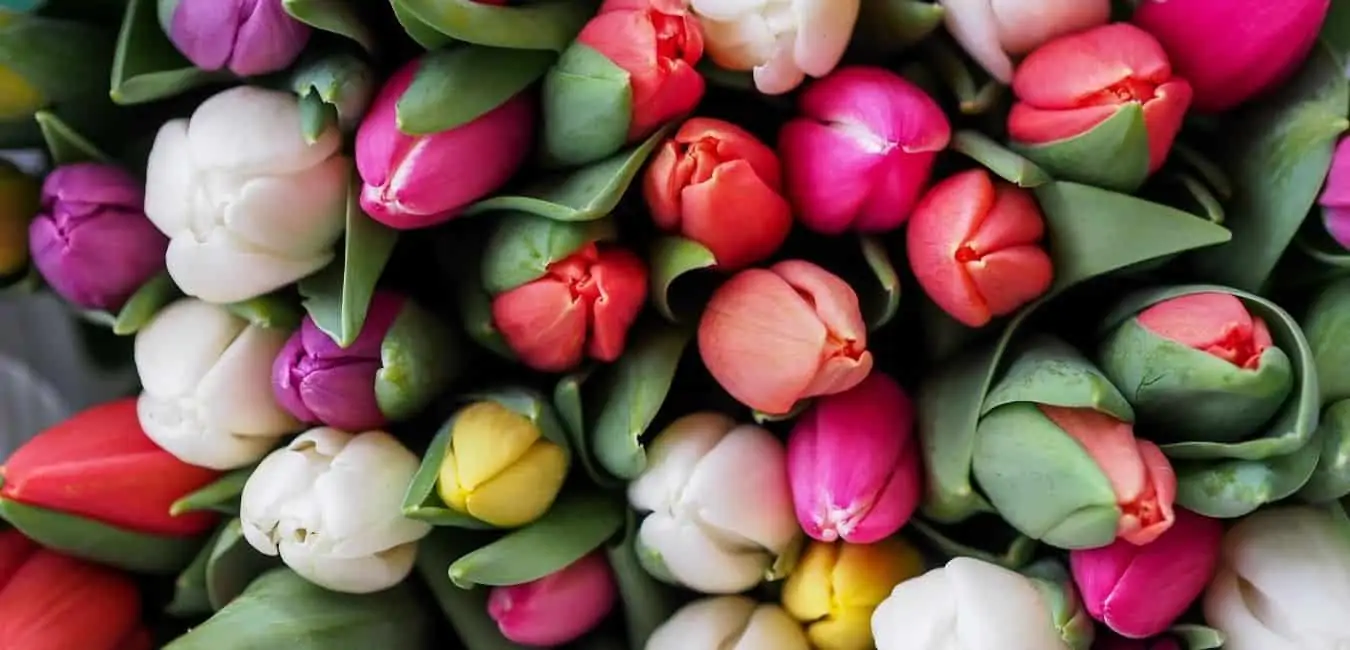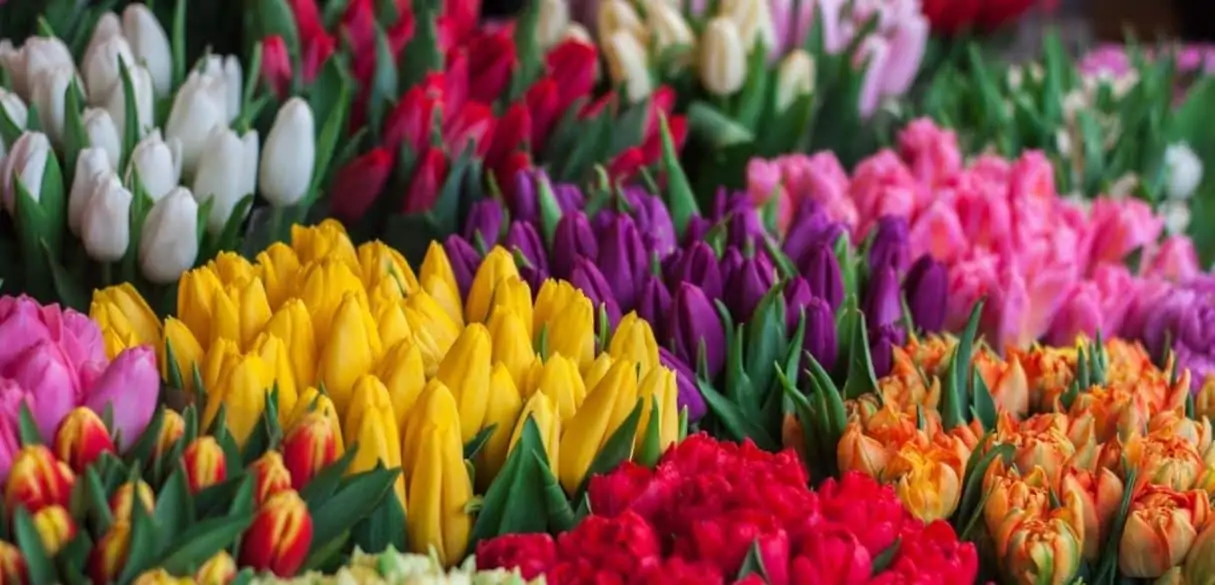Do you Know the Water Requirements of Tulip Plants? If not then don’t worry we will discuss it together in detail. Tulips (Tulipa spp.) is winter to spring perennial flower. It is hardy in USDA hardiness zone 3 to 8 and some parts of zone 9. You can grow Tulips in zone 10 and 11 only in winter or winter-like conditions. Tulips are native to the steps of Holland. Today Tulip is the national flower of the Netherlands. In its native climate tulips can grow in sandy rocky soil with low moisture content. Generally, a Tulip plant doesn’t require much water to grow or thrive. All it needs is a maximum of 1-inch water per week, especially in the growth period.
If you like Tulips and want to grow them in your garden then you have to stick to its basic requirements. Keep reading to know more about the watering needs of a tulip plant.
Water Requirements of Tulip Plant: 1-inch or approx 2 liters per week

Check out my previous post: Tulip Temperature Requirements: Everything to Know
General Water Requirements of Tulip
A Tulip plant requires only 1-inch water per week. Don’t worry if you can’t measure that. Just make sure the topsoil feels dry on touch but cold beneath 2-inch depth. Use your knuckle to dig deep in the soil to test the moisture. If you find dry first at 2 or 3-inch depth then it’s time to water the Tulip plants.
If you are not comfortable with getting your hand dirty then use a moisture meter. It will inform you about the optimum soil moisture level. You can keep track of the water for your lovely tulips.
You can still determine the water requirements by observing the initial drooping effects on the leaves. First of all water, the Tulips thoroughly and observe them for a couple of days. Makeout the day when the lower leaves start drooping. Nextime lower the water and test again. Don’t worry the plant will not get any damage as it is normal to droop in low moisture levels. It will revive once you water gain.
You will get the optimum water requirement for 4 to 7 days within a couple of tries. This is a layman technique but works great for every garden plant. I’ve been using and relying on the effectiveness of this method for the last 6 years.
Have a look at These Gardening Tools
Also read: Why is My Tulips Turning Yellow? 12 Reasons to Know
How much water is required to Vernalize Tulip Bulbs?
Vernalization is the technique of artificial wintering of Tulip bulbs. The Tulip bulbs contain all the necessary nutrients and moisture to stay alive during this phase. So most Tulip varieties will require very little to no water at all during initial vernalization.
You can simply place the Tulip bulbs wrapped in cocopeat or dry soil mix inside the cooler. Though you have you apply little water to keep the roots healthy and hydrated during the final stages of vernalization. You should moist the coco peat after 10 days or maybe 2 weeks of cooling the bulbs.
The roots may have started developing by this time. The moisture will hydrate the roots and prevent them from breaking.
Commercial growers moist the coco peat or moss beforehand just to ease out the handling process. Otherwise, they have to water the bulbs in the cooler one by one after a couple of weeks. This can be tedious especially if you have 100 or 1000s of bulbs to vernalize.
Special Tips: Professionals soak the Tulip bulbs in water mixed with 2% fungicide, 5% liquid consortia-a biological growth promoter, and some other micronutrients. This can help us excluding the water requirement during the vernalization of the Tulip bulbs.
Water Requirement for Tulips during Forcing
New roots will develop by the end of the vernalization phase. This is the time to shift these bulbs to growing media. You can place these bulbs directly in the garden beds especially if the outside temperature is above 55 degrees. There you will have to water the bulbs once every week without letting them dry. This is the most crucial phase of Tulip growth. If you miss the watering and if the roots dry then the plant may die before sprouting.
Now if you want to force the tulip to bloom in your time. Then you have to increase the temperature around 55 to 60 degrees in a controlled state. This condition is best achieved in a greenhouse. You can place the vernalize Tulip bulbs in growing media in containers. Keep the media or soil mix light and porous to allow proper drainage.
In both situations don’t water the bulbs more than 1 inch per week. If the soil stays moist for long then lower the watering to 2/3 or 1/2 inch per week.

Check out: How to Remove Wilted Tulip after Blooming?
Special Tips: Some professionals use lukewarm water to force the bulbs to bloom faster. Lukewarm water can increase the temperature quicker than warm airflow. It can damage the bulbs if the water is hot and boiling. So use this technique in a couple of bulbs as a try before final application.
How much water is required once Tulip stops blooming?
Tulip plants won’t require much water once it stops blooming. Only 1/2 inch water per week should be sufficient to keep it alive. Although you should Continue watering your tulips with 1-inch water per week throughout the growth period. this water will help the bulb to grow bigger and store as much moisture as it can. You can reduce the watering once the Tulips start wilting at the end of the blooming season.
If you want to dig up and store the bulbs for next season. Then stop watering the plants once the last pair of leaves turn yellow and wilt. Don’t water the bulbs for at least 2 weeks. This will force the bulbs into shock and they became inert for the transition phase. This shock will help the Tulip bulb to preserve all its resources for the favorable climate to grow back. It will remain dormant and alive until you grow it again in favorable spring conditions.
Once the bulb sleeps you can dig it out of the soil. Clean, sort, and store them for next season’s growth. In this way, a simple watering change can help you preserve the Tulip bulbs for regrowth and transplantation.
You should read this: How to Grow Tulips in a Greenhouse?
Which is better for Tulips Shallow watering or deep watering?
Deep watering is always beneficial for Tulips grown in good soil conditions. If the soil has optimum moisture content then you need not worry about frequent watering.
But if the soil has poor drainage then you have to regulate the watering schedule. Either too dry or too wet soil can load up your watering schedule. You have to repeat watering twice or even thrice per week with a very light soil composition. In another case, you have to wait for 10 to 15 days for the soil to dry out before the next spell.
Shallow watering or low and frequent watering is especially helpful in such adverse soil conditions.
If you are fond of modern garden technologies as I do then you can adapt to the Drip watering system. It is a great technique to regulate between deep and shallow watering whenever required without much manual effort.
It only requires drips to be placed carefully near the rootball at a specified depth. The rest of the work will be handled by the regulators installed. They will release only the limited amount of water prespecified at the time of installation. It can greatly ease the task of watering at a one-time installation cost. Isn’t it nice? 60% of my plants are installed with these drips and they are doing great.
Impact of Overwatering and Underwatering on Tulips?
Both Overwatering and Underwatering can be harmful to the Tulips. Although it is Overwatering that usually kills the plant instead of underwatering. A tulip plant can survive a dry spell of several days but can die in soggy soil within 3 days.
Common symptoms of Overwatering Tulips are- Yellowing of leaves, dark brown patches, unusual drooping, discoloring of flower petals, increased pest attack, stink smell around the root, and rootrot. If you found any of these symptoms when the soil is still wet then immediately stop watering the plant.
Checkout fr clogged drainage holes in the container or low-lying areas in the garden. The best option is to shift the plant to another dry container with little dry soil mix. As an alternative, you can add dry soil above the moisture after cleaning the drainage holes. In garden beds try to grow the plants in at least 8 to 10 inch raised beds.
Underwater has similar effects like yellow leaves, dry scales, brown patches, frizel leave surface, browning and curling of leaf edge, and finally drying, shrinking, and deformation of the bulbs.
Generally underwatering is rare with home gardeners. You should worry about the temperature during sunny days and water as usual-1inch per week. This should be enough for the Tulips to stay alive, grow, and bloom in time.
Is Spraying water good for Tulip Foliage?
You can spray water mixed with seaweed extract to feed the Tulip Plants. Also, fungicide and pesticides can be sprayed to keep the Tulips healthy. But you should avoid unnecessary watering with spray or water jets, as it can leave droplets on the foliage. These water droplets can gather pests and bacterial infections.
Also, avoid watering in any case after sunset. If you water the Tulips after sunset and water stays on the foliage then it is likely to attract lots of aphids, mealybugs, spider mites, and nematodes. It is always better to water or spray Tulips in the morning to avoid moisture deposition around the leaves and foliage.
You should read this before leaving: When to Plant Bulbs in Greenhouse?
Final Word
The water requirements of the Tulip plant are quite simple. A Tulip plant requires at most 1-inch water per week. You can play around with the water amount according to the soil condition and surrounding temperature.
You can also adapt to the layman technique of pouring 1 glass or 250ml water in an 8-inch Bulb pan every alternate day. This is sufficient for the Tulips to grow. If the container is bigger than 10 inches then pour 1 bottle or 1liter of water and wait for it to dry out in a couple of days before the next spell. The water should come out of the drainage hole every time you pour it into the container. Avoid overwatering more than underwatering. Underwatering won’t kill the Tulips but overwatering surely can kill it. The root rot disease mainly occurs due to overwatering. Therefore lit the water as required by the Tulip plants.
Keep Reading keep gardening!
